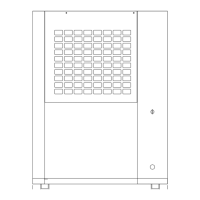
Do you have a question about the Quantum 67ACW2-134 and is the answer not in the manual?
| Category | Heat Pump |
|---|---|
| Refrigerant | R410A |
| Operating Temperature Range (Heating) | -15°C to 24°C |
| Weight (Indoor Unit) | 12 kg |
| Weight (Outdoor Unit) | 35 kg |
| Noise Level (Indoor) | 45 dB |
| Noise Level (Outdoor) | 55 dB |
Owner details for warranty and service records, including name and address.
Installer information for record-keeping, such as name, signature, and date of installation.
A log for recording all maintenance and service work performed on the appliance.
Decoding the unit's model number to understand its specific features and configuration.
An overview of the heat pump water heater's design, components, and key features.
Steps to follow when inspecting the unit upon arrival to check for damage and verify specifications.
Technical specifications, weight, and dimensional drawings for various models of the unit.
Safe procedures for moving and lifting the unit to prevent damage and personal injury.
Recommendations for selecting an optimal installation site and preparing the foundation.
Specifies minimum clearances needed around the unit for airflow and servicing access.
Techniques to minimize operational noise transmission to the surroundings.
Recommendations for isolating the unit to prevent vibration transfer to the building structure.
Instructions for installing dampers on centrifugal fan models to prevent fan overload.
Information on the factory-supplied refrigerant charge critical for unit operation.
Guidance on plumbing, water flow, and system requirements for proper unit integration.
Details on the flow switch function to ensure minimum water flow for safe operation.
Information on the size and type of water connections for system plumbing.
Specifies the optimal range for condenser water flow for efficient heat transfer.
Specific installation advice for pool heater models, including bypass and sanitiser considerations.
Guidance on connecting the unit to building heating systems, including volume and schematics.
Diagram illustrating the overall heating system layout and component connections.
Requirements for field wiring, including wire sizing, electrical data, and connection diagrams.
Identification and description of controls on the unit's left, front, and enclosure panels.
Explanation of unit operation, user-adjustable settings, and button functions.
Detailed description of how the heat pump system functions under various conditions.
List of error codes, their meanings, and auto-reset or manual reset procedures.
Essential checks and preparations required before the initial start-up of the unit.
Steps for initial system start-up, parameter checks, and operational verification.
Describes the typical start-up and shut-down sequence of the heat pump unit.
Explanation of the compressor's thermal overload protection and reset button.
Details on safety alarms that shut down the unit to prevent equipment damage.
Information on the automatic de-icing function, its purpose, and activation.
General guidance on routine service checks for proper unit upkeep.
Procedures for checking compressor oil, noise, and sump condition.
How to interpret the sight glass for refrigerant charge, moisture, and system status.
Maintenance requirements for the evaporator fan motor, including lubrication and noise.
Procedure for periodically retightening electrical terminals for safety and reliability.
Instructions for cleaning evaporator coils to maintain optimal heat transfer.
Guidance on regularly checking operational current, temperatures, and pressures.
Critical safety warnings and cautions for personnel performing service on the unit.
Procedure for adjusting the TX valve to set and maintain proper superheat.
Instructions for monitoring pressure drop and replacing the filter drier.
Information regarding any necessary maintenance for the liquid line solenoid valve.
Explanation of optional control features, such as the hot gas bypass system.
A guide to identifying and resolving common issues with the heat pump system.
Details the duration, coverage, and limitations of the manufacturer's warranty.
Lists specific items, conditions, and damages not covered under the warranty.
A list of checks to perform before contacting service to expedite troubleshooting.
